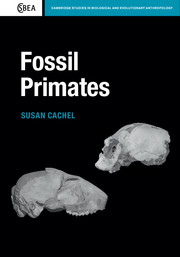Book contents
- Frontmatter
- Dedication
- Contents
- Acknowledgments
- Preface
- 1 Introduction: primates in evolutionary time
- 2 Primate taxonomy
- 3 Fossils and fossilization
- 4 The world of the past
- 5 The lifeways of extinct animals
- 6 Evolutionary processes and the pattern of primate evolution
- 7 Primate origins
- 8 The Paleocene primate radiation
- 9 The Eocene primate radiation
- 10 The Malagasy primate radiation
- 11 The Oligocene bottleneck
- 12 Rise of the anthropoids
- 13 The platyrrhine radiation
- 14 The Miocene hominoid radiation
- 15 The cercopithecoid radiation
- 16 Late Cenozoic climate changes
- 17 Conclusions
- References
- Index
3 - Fossils and fossilization
Published online by Cambridge University Press: 05 April 2015
- Frontmatter
- Dedication
- Contents
- Acknowledgments
- Preface
- 1 Introduction: primates in evolutionary time
- 2 Primate taxonomy
- 3 Fossils and fossilization
- 4 The world of the past
- 5 The lifeways of extinct animals
- 6 Evolutionary processes and the pattern of primate evolution
- 7 Primate origins
- 8 The Paleocene primate radiation
- 9 The Eocene primate radiation
- 10 The Malagasy primate radiation
- 11 The Oligocene bottleneck
- 12 Rise of the anthropoids
- 13 The platyrrhine radiation
- 14 The Miocene hominoid radiation
- 15 The cercopithecoid radiation
- 16 Late Cenozoic climate changes
- 17 Conclusions
- References
- Index
Summary
The origin of fossils
After an animal dies, its behavior immediately stops. Of course! Thus, behavior is the first component of the phenotype to be lost. After this, DNA and soft tissues are also rapidly lost. Large and small animals may eat or scavenge the carcass, dismembering the body, stripping away flesh, and breaking open bones that are rich in marrow. Bacteria and fungi alter soft tissues as decay takes place. Nevertheless, soft-bodied organisms may be preserved as flattened carbon films, preserved as calcium phosphate, or altered by early mineralization. For example, in the 425 mya Eramosa Formation of Canada, animal tissues containing melanin were altered by sulfur early after death; this caused resistance to bacterial decay (von Bitter et al., 2007). Exceptionally well-preserved material from this formation disproved an idea that shallow marine fossils after the Cambrian would be unlikely to fossilize in great detail. It had previously been thought that an increase in burrowing organisms after the Cambrian would irretrievably alter sediments. Specimens from the Eramosa Formation show that this is not necessarily the case.
However, it must be understood that the likelihood of any single ancient organism being preserved is miniscule. It is only the multitude of organisms living over vast reaches of geological time that allows these faint probabilities to emerge as recognizable fossils. A special sub-discipline of paleontology has been created to study all of the processes that affect an organism immediately after death until its discovery as a fossil. This is taphonomy. Techniques used by paleontologists to study taphonomy and taphonomic processes affecting fossils are also used by archaeologists when analyzing archaeological materials and sites. They are also used by forensic anthropologists when analyzing material from a crime scene, especially when considering events around the time of death and after death (Klepinger, 2006).
- Type
- Chapter
- Information
- Fossil Primates , pp. 36 - 58Publisher: Cambridge University PressPrint publication year: 2015



